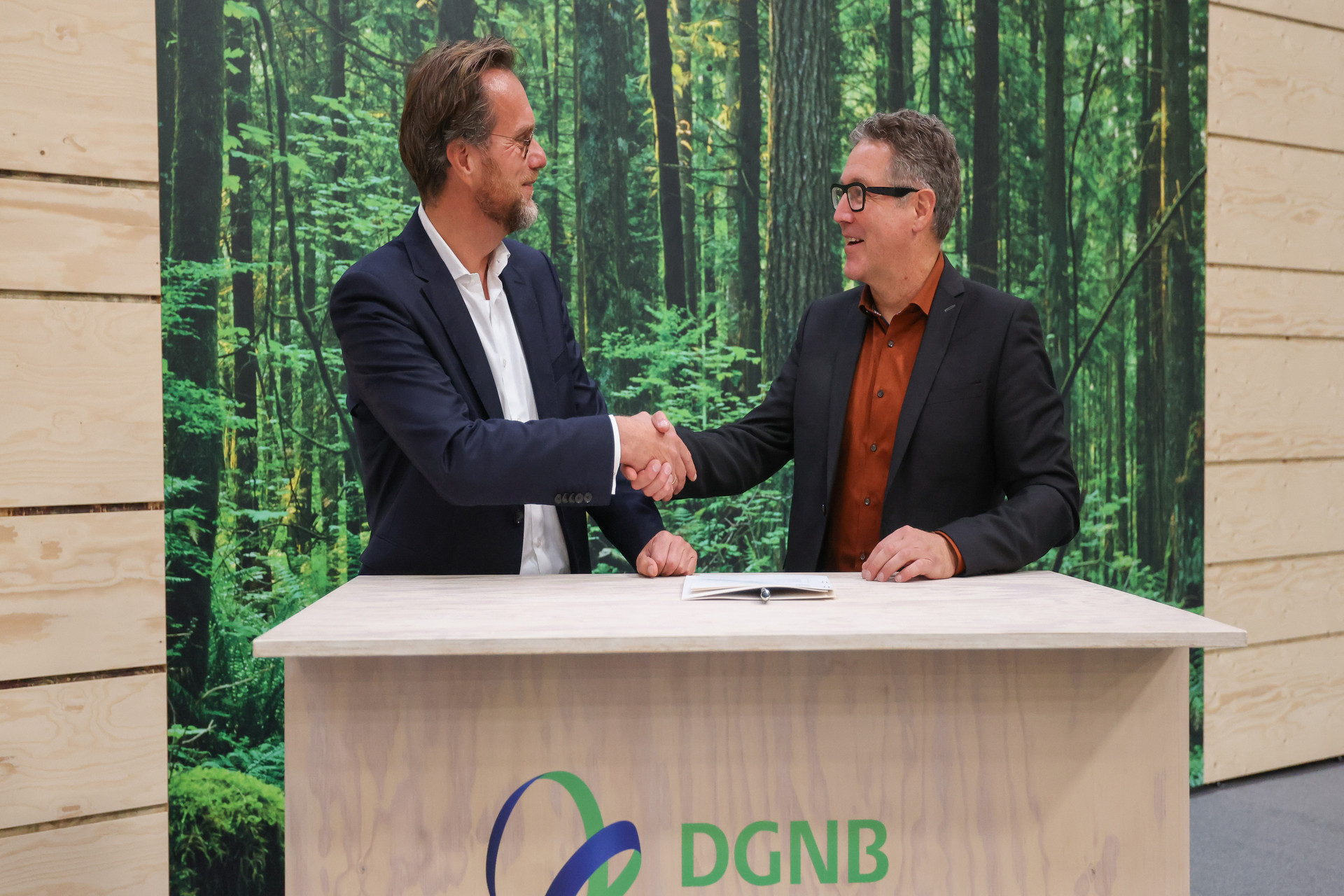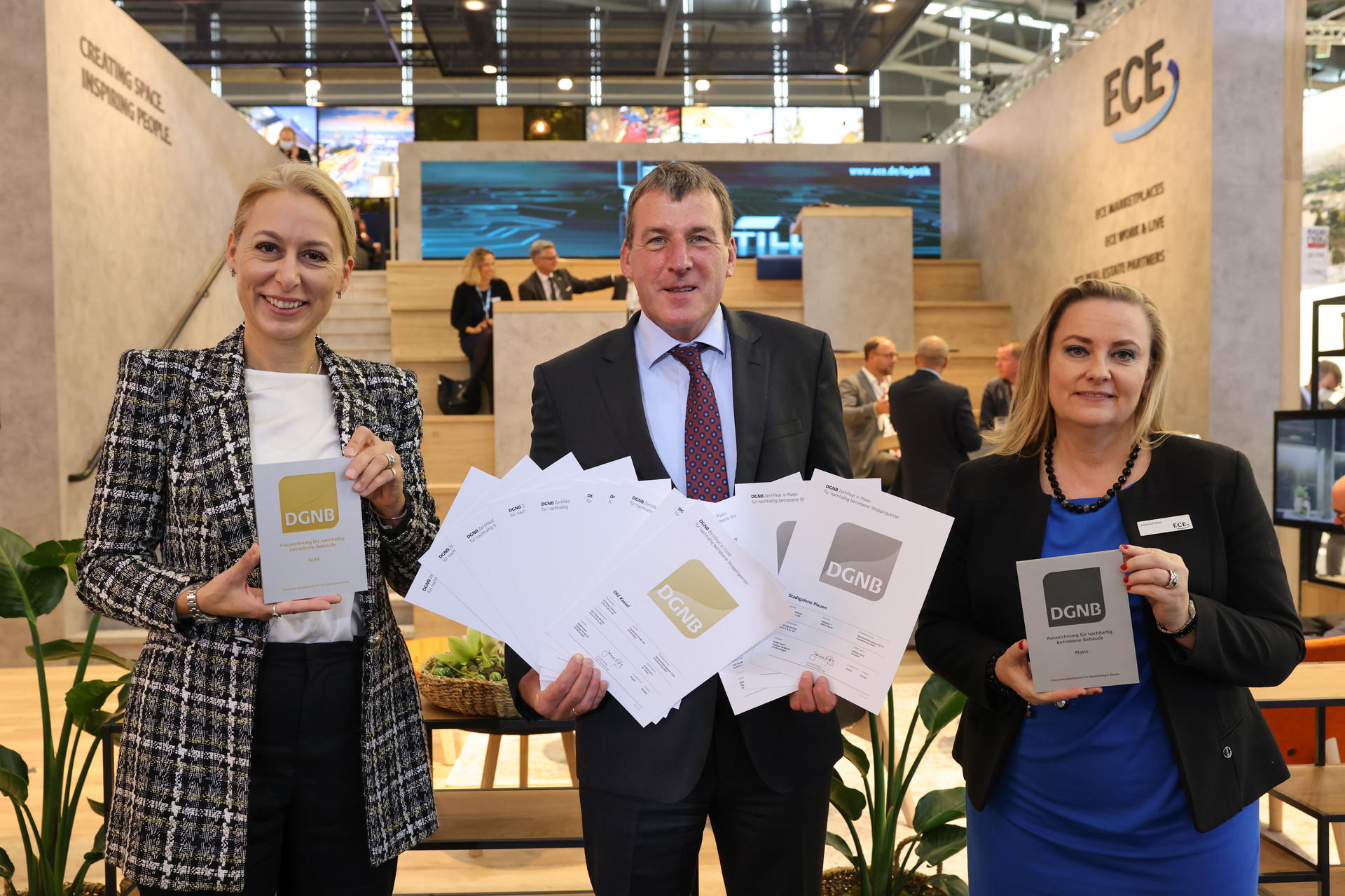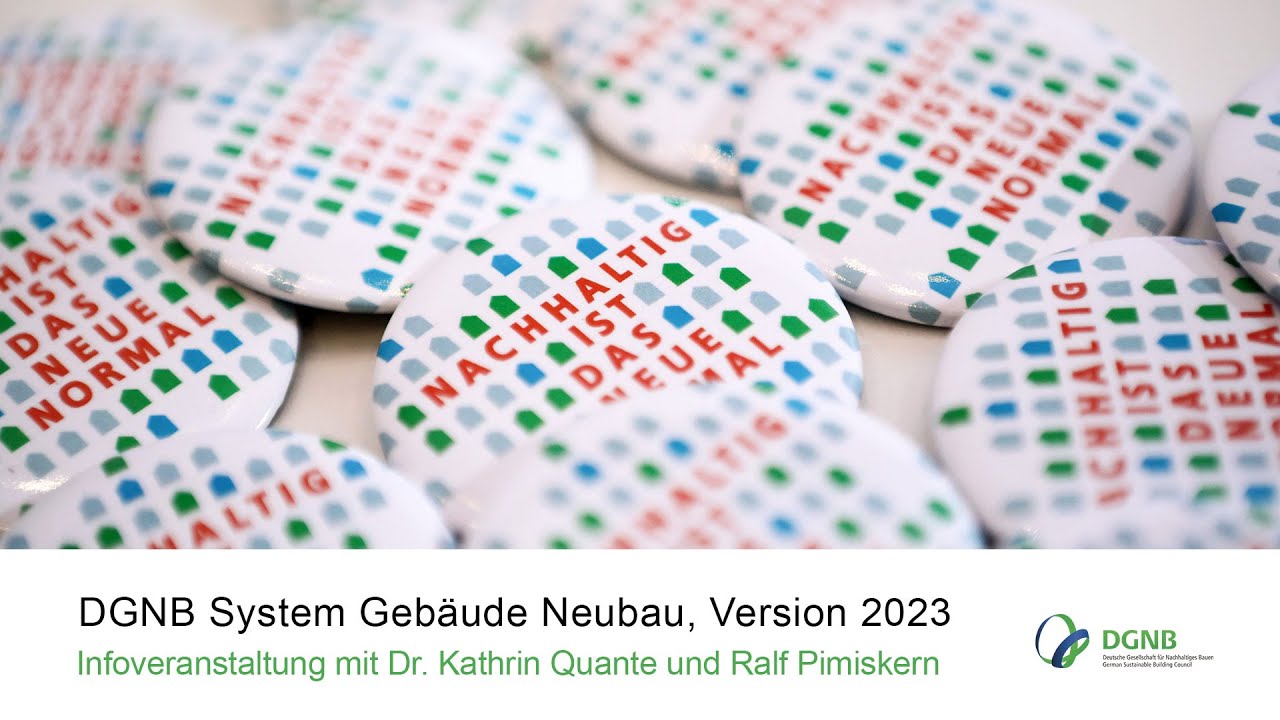The building sector has a key role to play in realising our sustainability and climate action goals as well as all the multiple challenges associated with them. The effects of climate change can only be limited through the immediate and massive reduction of CO2 emissions. It is about the adequate, preventive adaptation of our built environment to the increasingly far-reaching changes of the climate. About preserving natural resources and ecosystems to protect our livelihoods. About achieving geopolitical independence via a consistently circular approach to planning and construction. And all of this in a way that has positive effects for people as building users and is economically sensible and affordable in the long term.
The 2023 version of the DGNB System for New Construction of Buildings was developed against this very background in an extensive participatory process with the involvement of a large number of experts from all areas of sustainable construction.
As a planning and optimisation tool, the new system version provides targeted support to builders, project developers, architects and planners in finding the best individual solutions for their projects. The connectivity to other assessment schemes such as the EU taxonomy, the quality label "Qualitätssiegel Nachhaltiges Gebäude" (QNG), the EU reporting framework Level(s) as well as the Sustainable Development Goals (SDGs) was taken into account.
DGNB System Small Residential Buildings Renovation / New Construction, Version 2024
Would you like to certify a new construction project in the residential sector with a maximum of twelve units? The DGNB has developed its own system variant for this.
LEARN MORE
The DGNB System for New Construction of Buildings, Version 2023 is applicable for the following schemes:
- Educational buildings
To the scheme
- Office and administrative buildings
To the scheme
- DGNB Flex
More about DGNB Flex
- Department stores
To the scheme
- Healthcare buildings
To the scheme
- Hotels
To the scheme
- Logistics buildings
To the scheme
- Mixed use
To the scheme
- Production buildings
To the scheme
- Shopping centres
To the scheme
- Consumer markets
To the scheme
- Assembly buildings
To the scheme
- Residential buildings (since 2023 version: more than 5 residential units)
To the scheme
Please note: For small residential buildings, since 1 July 2024 the current DGNB System for the Renovation or New Construction of small residential buildings (up to 12 residential units), Version 2024, applies.
In addition, there are some schemes that are currently in their pilot phase. You can find an overview of all schemes here. If your project type is not yet included in the DGNB System, you can find all the information about DGNB Flex here.
During the development of the 2023 version of the certification system for new constructions, optimum compatibility with other DGNB assessment systems was ensured. This applies to the variants of the DGNB System for Buildings In Use, for sustainable construction sites and the DGNB System for Deconstruction.
In addition, the criteria of the DGNB System are harmonised with the requirements of other systems and classifications. This means that anyone carrying out DGNB Certification will not have any parallel documentation requirements, but can use the DGNB Certificate as a verification tool for national and international standards. The DGNB has carried out such a system harmonisation for the following systems:
- EU taxonomy
- EU reporting framework Level(s)
- Quality label "Qualitätssiegel Nachhaltiges Gebäude" (QNG), to which the Federal Subsidy for Efficient Buildings (BEG) is linked
- Sustainable Development Goals (SDGs) of the United Nations
In the criteria set, the relevance of the individual DGNB criteria for the respective systems is marked with an icon. You can find out how they relate to each other in the system comparison documents.
Certification criteria
The DGNB system does not evaluate individual measures, constructions or components, but the overall performance of a building based on criteria. If these criteria are met in an outstanding manner, the building receives a certificate or pre-certificate in Platinum, Gold or Silver.
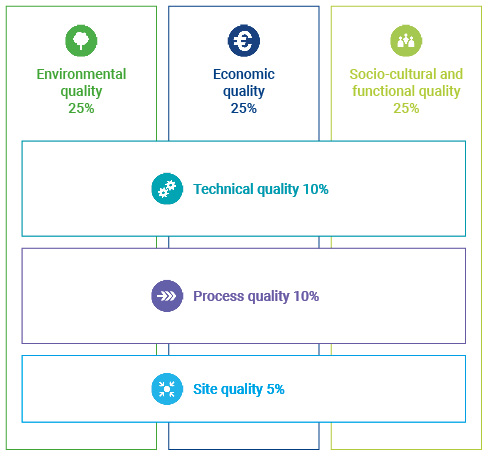
The DGNB System for New Construction of Buildings, Version 2023 is based on the three central sustainability areas of environmental, economic and sociocultural aspects, which are given equal weighting of 25 per cent in the assessment. In terms of a holistic approach, the DGNB System also assesses the location with 5 per cent and the technical and process-related quality with 10 per cent each.
The system comprises a total of 29 criteria, the number of which is distributed across the topic areas as follows:
- Environmental quality: 6 Criteria
- Economic quality: 4 Criteria
- Sociocultural and functional quality: 6 Criteria
- Technical quality: 4 Criteria
- Process quality: 6 Criteria
- Site quality: 3 Criteria
It should be noted that not every criterion is relevant for every scheme. Depending on the scheme, the weighting of the individual criteria may vary. You can download the complete DGNB criteria set below.
The criteria of environmental quality allow an assessment to be made with regard to the effects of buildings on the global and local environment as well as the impact on resources and the generation of waste.
- Climate action and energy (ENV1.1)
- Local environmental impact (ENV1.2)
- Responsible resource extraction (ENV1.3)
- Potable water demand and waste water volume (ENV2.2)
- Land use (ENV2.3)
- Biodiversity at the site (ENV2.4)
The criteria of sociocultural and functional quality help to assess buildings with regard to health, comfort and user satisfaction as well as the essential aspects of functionality.
- Thermal comfort (SOC1.1)
- Indoor air quality (SOC1.2)
- Sound insulation and acoustic comfort (SOC1.3)
- Visual comfort (SOC1.4)
- Quality of indoor and outdoor spaces (SOC1.6)
- Barrier-free design (SOC2.1)
The criteria of process quality aim to increase the planning quality and the construction quality assurance.
- Quality of project preparation (PRO1.1)
- Ensuring sustainability aspects in tendering and contracting (PRO1.4)
- Procedure for urban and design planning (PRO1.6)
- Construction site / construction process (PRO2.1)
- Systematic commissioning (PRO2.3)
- Preparation for sustainable use (PRO2.5)
Work aids for climate risk analysis and climate adaptation
- List of providers and products for professional climate risk services (assessment – management – reduction)
- Collection of freely available online resources on environmental hazards caused by climate – nature – civilisation
- Overview of possible adaptation measures for climate hazards (heat – drought | heavy rain – flooding | thunderstorms – hail)
- Strategic work aid incl. possible measures for local authorities to use in their heat action planning
Certification requirements
At the time of certification, the building should not have been completed or commissioned more than three years ago. If it is intended to certify a new building that was completed or commissioned more than three years ago, this must be agreed with the DGNB Office via a project-specific request for certifiability (PCQ) by a DGNB Auditor before the project is registered. As a rule, it is always possible to certify a building according to the current system.
The principle of minimum requirements is applied to all those issues that are non-negotiable for a sustainably planned and built property with a view to its future viability. Some minimum requirements are mandatory in order to be certified at all. Others are required to achieve a DGNB Certificate in Platinum, the highest level awarded.
Minimum requirements by criteria for all buildings:
- ENV1.1: Disclosure of life cycle assessments and, for buildings not yet designed for net greenhouse gas neutral operation at the time of completion, a "Climate Action Roadmap for Climate Neutral Operation - Target Year According to National Targets".
- ENV1.3: It must be demonstrated that at least 50 percent (by mass) of the permanently installed wood or wood-based materials used is sourced from certified sustainably managed sources.
- ECO2.6: For all buildings, there is a "basic resilience" to climate risks.
- SOC1.2: The indoor air quality measurement meets the minimum requirements for the assessment of indoor air concentration of volatile organic compounds.
- SOC2.1: Accessibility: Compliance with quality level QS1. This must be complied with for all uses (main, secondary and subordinate uses). Exceptions can be found in Table 2 in the criterion.
- TEC1.6: It must be demonstrated that circular aspects are taken into account in planning and implementation. For this reason, as a minimum requirement for certifiability, a deconstruction manual must be submitted or the minimum score of 20 points in the entire criterion must be demonstrated.
- PRO2.3: Development of an energy monitoring concept.
- SITE1.1: A climate risk analysis is available.
Minimum requirements for buildings seeking DGNB Certification in Platinum:
- ENV1.1: Disclosure of life cycle assessments and, for buildings that are not yet designed for net greenhouse gas neutral operation at the time of completion, an "Ambitious Climate Action Roadmap" for climate neutral operation.
- ENV1.2: Compliance with quality level QS3.
- ENV2.2: For a Platinum certificate, 40 points must be achieved in the criterion.
- ENV2.4: For indicator 2 "Habitat" a minimum of 25 points is required.
- ECO2.6: Significant measures to reduce all risks classified as high at the site are being implemented.
- SOC1.2: In mechanically ventilated buildings, the measurement and assessment of indoor air quality results in a TVOC indoor air quality value of less than 1000 μg/m³ and a formaldehyde value of less than 60 μg/m³.
- TEC1.4: Energy generation at the building: For the award level Platinum, a score of 5 points must be achieved in indicator 5.2.1.
- TEC1.6: For the DGNB Certificate in Platinum, if deconstruction has taken place, a justification for the deconstruction must be provided and (also applies to projects without prior deconstruction) the minimum score of 40 points in the overall criterion must be demonstrated.
- TEC3.1: A minimum score of 40 points must be demonstrated in the entire criterion.
- PRO2.3: Commissioning of the regulation monitoring is available.
- SITE1.1: A qualified climate risk analysis is available.
If individual regulations exist for individual schemes with regard to the minimum requirements, these are listed in the criteria set under the section "scheme-specific information".
Expert reports, analyses and simulations must make reference to the current planning status or the building as it was actually constructed. If expert reports and simulations made reference to a previous planning status, evidence must be provided to clearly demonstrate that they continue to be valid and relevant.
Primary use: The scheme with the largest share of the total DGNB assessment area is designated as the primary use. In the case of mixed use, the scheme with the largest share of space is designated as the primary use. If classification is not clearly possible (e.g. 40 percent office, 40 percent residential, 20 percent commercial building), the auditor must determine the primary use and justify the decision.
Secondary use: One or more uses that are assigned to a different scheme than the primary use and whose area share of the total DGNB assessment area is ≥ 15% are referred to as secondary use. The areas of a secondary use must be evaluated with the corresponding scheme. If there is at least one secondary use, the building under consideration must be evaluated according to the mixed use application rules.
Subordinate use: One or more uses that are assigned to a different scheme than the primary use and whose area share is < 15 % (or in case of several schemes < 30 %) of the DGNB assessment area are referred to as subordinate use. These areas are to be assigned to the primary use and are to be evaluated according to the primary use scheme. If there are several secondary uses < 15% of DGNB assessment area and the sum of their area shares in the DGNB assessment area is ≥ 30%, the subordinate use with the largest area share is to be considered as secondary use.
Certification is possible as a single certification, ensemble certification and multiple or serial certification. Unless otherwise stated in the individual criteria, only the building and the open spaces directly associated with it are considered.
Standard case: One certificate for the entire building
Certification is possible as a single certification, ensemble certification and multiple or serial certification. Here you will find the delimitation rules for the classification of project certifiability. Unless otherwise stated in the individual criteria, only the building and the open spaces directly associated with it are considered.
If a different certification is intended, this must be agreed with the DGNB Office via a project-specific request (PCQ) in the DGNB System Software by a DGNB Auditor before the project is registered.
More than one certificate
Buildings are to be certified separately if the building structures are clearly separated from each other. The underground car park is to be allocated to the building structures in accordance with the parking space certificate.
If a different certification is intended, this must be agreed with the DGNB Office via a project-specific request (PCQ) in the DGNB System Software by a DGNB Auditor before the project is registered.
Several buildings on one property
Ensemble certification is possible for buildings on a site that are largely identical in construction. This must be agreed with the DGNB Office via a project-specific request (PCQ) in the DGNB System Software by a DGNB Auditor before the project is registered.
More about ensemble certification
Identical buildings at different locations
This form of certification is used for structures such as consumer markets or prefabricated houses that are built identically at different locations.
More about multiple certification
Awards
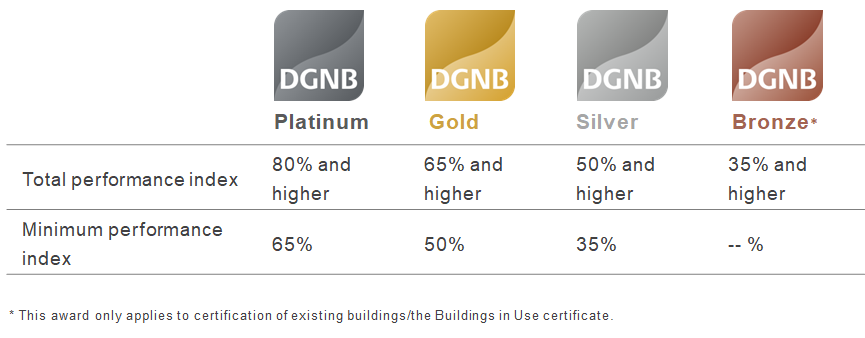
As with the other DGNB Certification Systems, the DGNB System for New Construction of Buildings assesses fulfilment levels. The overall degree of fulfilment is calculated from the assessment of the individual criteria. The highest award level is Platinum.
From an overall degree of fulfilment of 50 percent, the building receives the DGNB Certificate Silver. From a degree of fulfilment of 65 percent, the DGNB Certificate Gold is awarded. For a DGNB Certificate Platinum, the project must achieve an overall degree of fulfilment of 80 percent.
The DGNB aims to promote a uniformly high quality of buildings. The overall degree of fulfilment alone is therefore not sufficient for a certificate. In the topic areas of ecological, economic as well as socio-cultural and functional quality, a minimum degree of fulfilment must be achieved in each topic area in order to receive the corresponding award. For Platinum, for example, a degree of fulfilment of at least 65 percent is required in these first three subject areas. A degree of fulfilment of at least 50 percent is a prerequisite for a certificate in Gold. For Silver, the threshold is 35 per cent per topic area.
DGNB Diamond
In addition, projects that have received DGNB Gold or Platinum can also be recognised for their outstanding design and architectural quality by being awarded the DGNB Diamond. All information on the DGNB Diamond can be found here.
Project registration
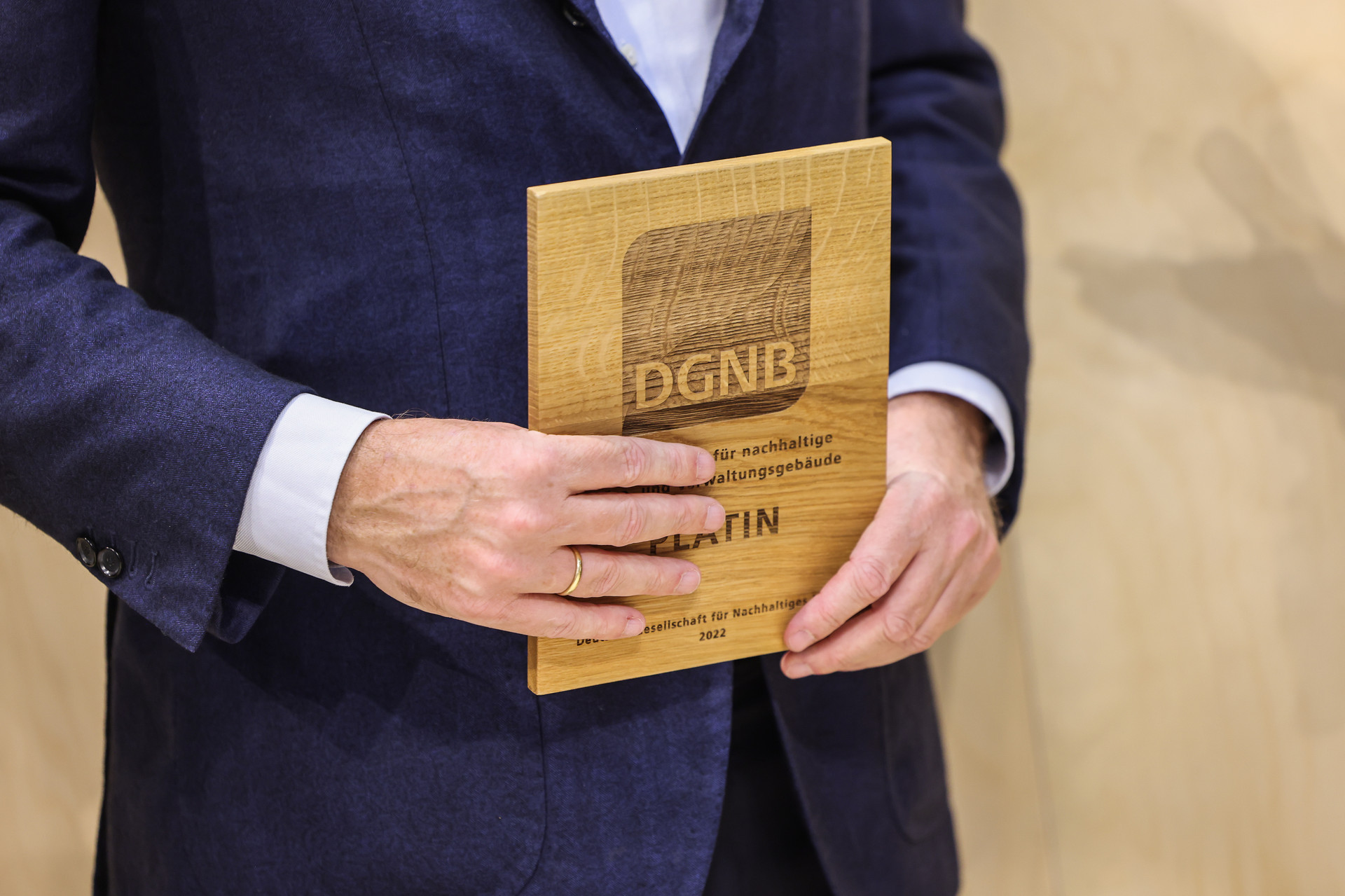
To register a project, clients must first hire a DGNB Auditor. This auditor can then register the project. Auditors also accompany the entire process and take over the verification and submission to the DGNB. They are active worldwide and specialise in certain schemes.
Projects can be registered with "New Construction of Buildings, Version 2023".
Note: For projects already registered, the system version valid at the time of registration applies. However, it is possible to switch to the new version in consultation with the certification body.
Projects that are already registered for certification in accordance with the DGNB System New Construction of Buildings , Version 2018 must submit the signed contract documents to the DGNB by 31 October 2024.
Projects that are aiming for the quality label "Qualitätssiegel Nachhaltiges Gebäude" and have submitted a PCQ request to the DGNB by 31 July 2024 can still register their project for certification in accordance with the DGNB System New Construction of Buildings, Version 2018 until 31 December 2024. The contract documents must be signed and received by the DGNB by 28 February 2025.
For all other projects, registration is only possible in accordance with the 2023 version (since 1 December 2023).
The most important information on the dgnb system for new construction of Buildings, version 2018
Specific applications
Within the scope of certification for new construction, there are further award and application options that address potential special features in construction projects. These specific applications include:
Further information
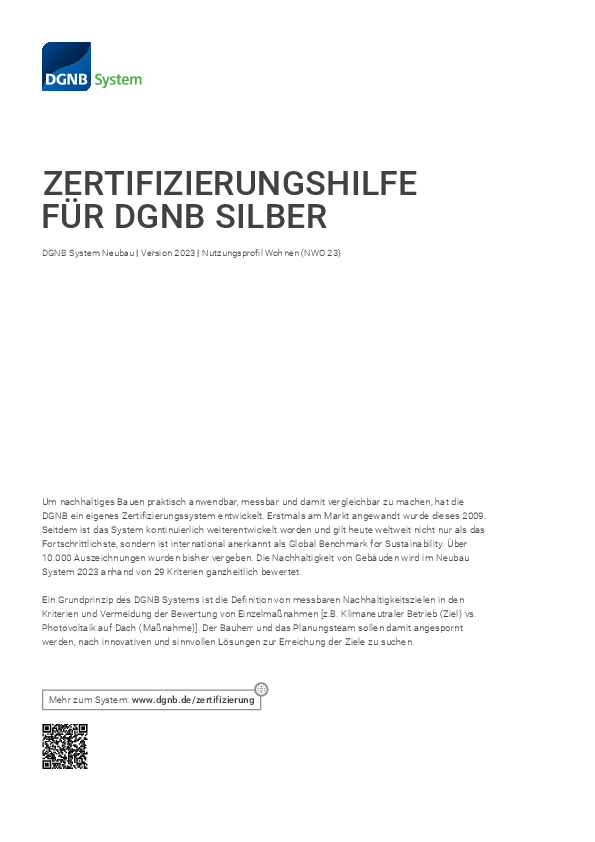
Certification assistance for DGNB Silver
Selected DGNB certified projects
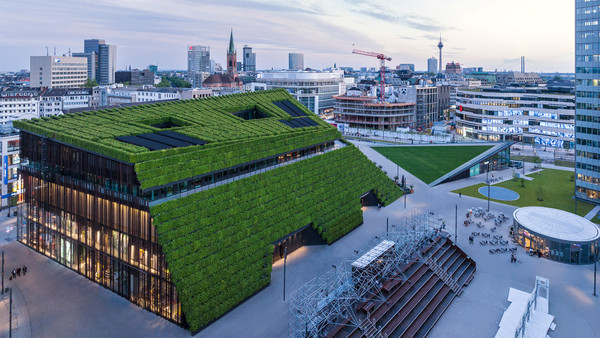
Department Stores
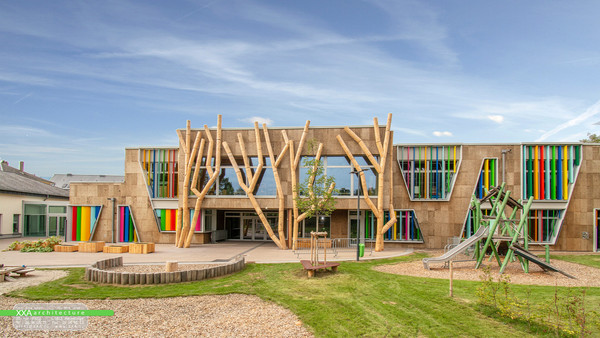
Educational Buildings
Frequently asked questions
The DGNB is pursuing the following goals with the 2023 system version:
- Sharpening requirements, especially with regard to future climate goals
- Streamlining the system by reducing criteria / indicators
- Quality assurance through additional minimum requirements
- Improving the linking of the various DGNB Systems
- Integration of the requirements of the quality label "Qualitätssiegel Nachhaltiges Gebäude" and the EU taxonomy
- General optimisation of the application and elimination of inaccuracies
In part. The aim of the new version of the system is to make buildings sustainable. This means a higher level of ambition than in the 2018 version with regard to issues such as climate action, resource conservation, climate adaptation and mobility.
Other criteria, particularly in the area of sociocultural quality, have also had to be adapted due to changes in the DIN standards. This represents a change, but not necessarily a tightening.
In addition, some criteria, such as sound insulation, have been dropped.
There are no specifications for life cycle assessment tools. Therefore, both professional solutions and your own tools can be used. If professional tools are used, you will find an overview here for your guidance, without any claim to completeness. The information provided is self-declarations by the tool providers and has not been checked by the DGNB. In addition, the DGNB will shortly be offering an accreditation of life cycle assessment tools, which will confirm the accuracy of the calculations and use of data. The DGNB CO2 calculator can be used to create a climate action roadmap. Further information on life cycle assessment can be found here.
Currently, there is no standardised procedure for assessing and evaluating climate risks in buildings and real estate. Guidance is provided by the general guideline for assessing vulnerability and climate risks (DIN EN ISO 14091:2021-07), as well as regulatory requirements (e.g. the EU taxonomy) and approaches from private providers. There are no specifications as to which tools or providers are used to perform a climate risk analysis, e.g. for criterion SITE1.1 in the DGNB System or ESG Verification for the EU Taxonomy. Professional solutions, proprietary instruments or freely available sources can all be used. Further up on this page, you will find various work and guidance aids in the form of Excel documents for download, including:
- An overview with a selection of providers and products for climate risk services, which can help you choose a product that is suitable for your project (for the specific requirements of a taxonomy-compliant climate risk analysis, e.g. with regard to climate impacts and future data considered)
- A filterable overview of geo-portals and online resources on climate and environmental hazards (in case you are conducting the climate risk analysis yourself)
- A guide to possible climate adaptation measures across all subject areas
- A locally adaptable work aid for the specific challenge of heat protection planning at the municipal level, developed in cooperation with the 'Klimapositive Städte und Gemeinden' (Climate-Positive Cities and Municipalities) initiative.
When developing the criteria, the requirements from the systems/classifications mentioned were taken into account. Information on overlaps and synergies can be found in the respective system harmonisation documents. Anyone who carries out DGNB Certification will not have any parallel documentation work, but can use the DGNB Certificate as a verification instrument for national and international requirements. In the criteria set, the relevance of the individual DGNB criteria for the respective systems is marked with an icon.
In the development of version 2023, care has been taken to integrate the requirements of the quality label "Qualitätssiegel Nachhaltiges Gebäude" into the certification system to allow parallel processing. The new system version has been recognized by the DAkkS (German Accreditation Body) since 27 May 2024. As funding criteria are often changed at relatively short notice, it is advisable to check the current regulations at the start of a project.
The DGNB System New Construction of Buildings, Version 2023 only covers residential buildings with at least six units.
Projects for small residential buildings and apartment buildings with up to twelve units can be registered with the DGNB System Small Residential Buildings Renovation / New Construction, Version 2024 (in German).
As in the 2018 version, labels can be recognised for criteria ENV1.2 and ENV1.3. The content requirements for ENV1.2 are defined via the criteria matrix. For the content requirements with regard to criterion ENV1.3, compliance with defined criteria must be demonstrated in accordance with a separate document (based on the 2018 version) for label recognition. The separate document will be published shortly.
There are four major urban development projects in Hamburg under the management of HafenCity Hamburg GmbH and its subsidiaries: HafenCity, Billebogen, Grasbrook and Science City Hamburg Bahrenfeld. In an effort to realise consistently high sustainability standards in the neighbourhoods, sustainability certification has been a prerequisite for the allocation of land here since 2010. Since 2017, it has also been mandatory for all new buildings to achieve the highest award of HafenCity's own certification system. In 2023, this was replaced by a new award developed in cooperation with the DGNB: the DGNB special award Ecolabel. The DGNB special award Ecolabel covers key aspects of the previously independent "HafenCity 3.0 Ecolabel" and combines them with the benefits of the DGNB System.
For the further development of the DGNB System for New Construction to the 2023 version, extensive research and an intensive dialogue took place first. DGNB auditors and consultants, members of various DGNB committees (in particular the DGNB Technical Committee), DGNB management and DGNB employees were involved in this process.
A plan for the revision was drawn up on the basis of the extensive feedback. This was approved by the DGNB Technical Committee and the DGNB Management Board. A project team made up of DGNB employees from the Certification and Research and Development departments then revised the criteria in line with this plan.

